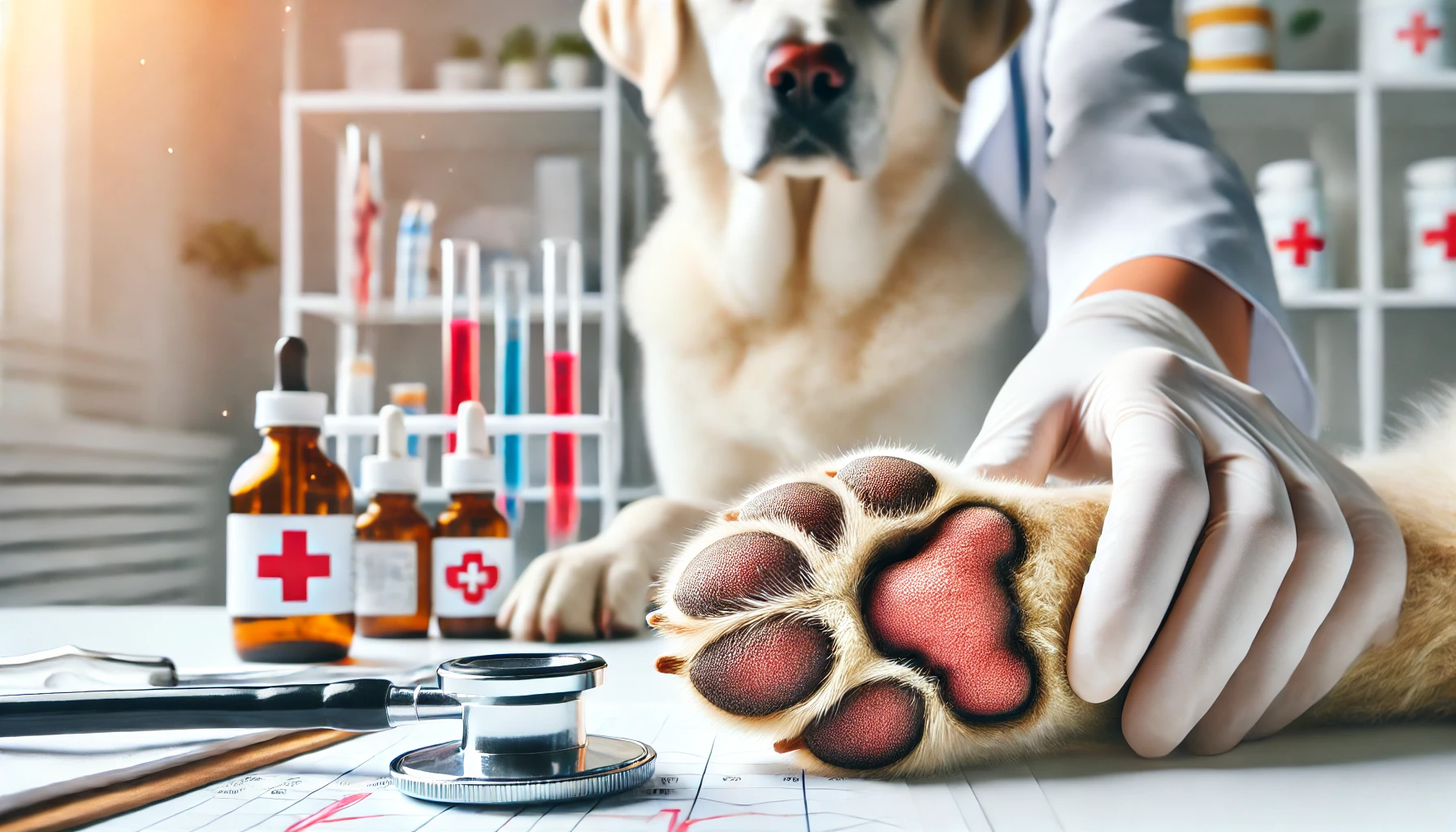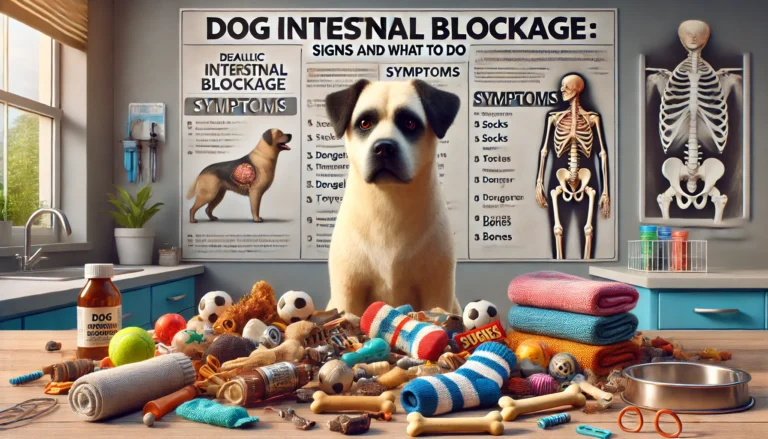Pododermatitis in Dogs-pododermatitis dog paw treatment

Pododermatitis in Dogs
what is Pododermatitis in Dogs?Pododermatitis in dogs refers to the inflammation of the skin or tissues of their paws. This condition can be caused by a range of factors, including allergies, bacterial or fungal infections, parasites, and trauma. Dogs with itchy feet or red skin between dog paws are commonly diagnosed with pododermatitis. The symptoms often include redness, swelling, sores between the toes, and constant paw licking.
Causes of Pododermatitis in Dogs
Pododermatitis is a symptom of underlying conditions. Some of the most common causes of paw infections in dogs include:
- Allergies: Dog paw allergies can cause inflammation and irritation, leading to dog licking paws raw and swollen toes.
- Fungal Infections: Fungus on dog paws, especially yeast infections, can result in symptoms such as a raw dog paw and redness between the toes.
- Bacterial Infections: Dog paw infection antibiotics are often prescribed when a bacterial infection like Staphylococcus is diagnosed.
- Parasites: Fleas and mites can also contribute to paw irritation, causing dogs to bite or chew their feet.
- Trauma: Dog paw sores between toes can be caused by injury or foreign objects, such as thorns or stones, embedded in the footpads.
Symptoms of Pododermatitis in Dogs
Key Symptoms of Pododermatitis in Dogs
The symptoms of Pododermatitis in Dogs can vary based on the severity of the condition, but the most common signs include:
- Redness between toes: One of the earliest signs is a noticeable red skin between dog paws or in between dog toes red.
- Swelling and tenderness: Dogs with pododermatitis may experience swollen paws or dog paw swollen red between toes.
- Painful paws: When touched, the dog may show signs of pain or reluctance to walk, indicating that dog’s paw is swollen and limping.
- Excessive licking and chewing: Dogs often lick their paws raw to relieve the itching, which can worsen the condition. Why do dogs lick their paws raw? This is usually due to inflammation or an underlying infection.
- Sores and crusting: Sore dog paws between toes treatment can help manage wounds, blisters, or pus-filled blisters on paw.
- Yeast or bacterial smell: An odor from infected paw pads or fungus on dog paws can indicate an ongoing infection.
Diagnosing Pododermatitis in Dogs
Veterinary Examination
To diagnose pododermatitis, a vet will typically conduct a thorough physical examination of the dog’s paws, focusing on areas that are red between the toes or raw from licking. The veterinarian may also take a skin scraping or perform cytology to identify whether bacteria or yeast is present.
Allergy Testing
If allergies are suspected as the cause of pododermatitis, the vet may recommend allergy testing, which could involve a blood test or skin test. Paw allergies in dogs are often triggered by environmental allergens like pollen or dust mites, but food allergies may also be responsible.
Cultures and Sensitivity Testing
In some cases, the vet may take cultures from the affected area to identify the exact cause of the infection, whether bacterial, fungal, or both. This is especially important for treating Pododermatitis in dogs paw infection and ensuring the correct medication is prescribed.

Treatment Options for Pododermatitis in Dogs
Antibiotics and Antifungals
If a paw infection is identified, your vet may prescribe topical or oral antibiotics to treat bacterial infections. Yeast infections are treated with antifungal medications. Pododermatitis cream can be applied to help soothe the affected areas.
Corticosteroids and Antihistamines
For allergy-induced pododermatitis, corticosteroids or antihistamines may be recommended to reduce inflammation and itching. However, long-term use of corticosteroids should be monitored due to potential side effects.
Home Remedies for Sore Dog Paws
In addition to veterinary treatments, there are home remedies for dog paws red between toes that can help manage mild cases:
- Epsom salt soaks: Soaking the paws in warm Epsom salt water can help reduce inflammation and promote healing.
- Aloe vera gel: Aloe vera can be applied topically to soothe irritated skin.
- Coconut oil: Known for its antibacterial properties, coconut oil can help treat dog paw infection between toes and moisturize dry paw pads.
do you know
Hyperkeratosis in dogs is a common condition that affects the skin’s keratin layer, leading to excessive and abnormal growth, particularly on the pads of their paws and noses. This guide delves deep into the world of hyperkeratosis, covering everything from causes and symptoms to treatment and management strategies for your furry friends.
Anti-Inflammatory Medications
NSAIDs (Non-steroidal Anti-Inflammatory Drugs) may be prescribed for pain and inflammation relief. These can help treat dog paw swollen areas and allow your dog to walk more comfortably.
Preventing Secondary Infections
While treating the primary condition, it is essential to prevent secondary infections. Dog paw disease can worsen if left untreated. Pododermatitis dog paw home remedy should be done with care, ensuring the paws are kept clean and dry.
Preventing Pododermatitis in Dogs
Regular Paw Care and Maintenance
To prevent pododermatitis in dogs, it’s important to regularly check your dog’s paws for signs of irritation, injuries, or infections. Ensuring that their paw pads remain healthy is key. Regularly trim the nails and clean between the toes to avoid the buildup of dirt and debris, which can contribute to infection.
Maintaining a Healthy Diet
Feeding your dog a balanced, hypoallergenic diet may help prevent food-related allergies, which are a common trigger for Pododermatitis in dogs. Providing a diet rich in omega-3 fatty acids can also help support your dog’s immune system and skin health.
Moisturizing and Protecting Paws
Using paw balms and moisturizers designed for dogs can help protect their feet from dryness and cracking. Paw balm for dogs can act as a barrier against environmental factors like salt or hot pavement, which can contribute to paw irritation.
Conclusion
Pododermatitis in dogs is a painful and often chronic condition in dogs that can be managed with early detection and appropriate treatment. Whether your dog’s paws are raw between the pads, swollen and itchy, or suffering from fungal infections, timely intervention is key to providing relief and preventing further complications. Understanding the underlying causes, such as allergies or infections, is crucial for effective management. By following the treatment protocols provided by your veterinarian and implementing preventive care, you can help ensure your dog’s paws remain healthy and pain-free.
How do you treat pododermatitis in dogs?
Treating pododermatitis in dogs requires identifying and addressing the underlying cause of the inflammation. Veterinarians often prescribe a combination of topical and systemic treatments. Topical therapies may include medicated shampoos, ointments, or creams that contain antibiotics, antifungals, or steroids to reduce inflammation and treat infections. Systemic treatments might involve oral antibiotics, antifungals, or anti-inflammatory medications. Addressing environmental factors, such as allergens, and managing the dog’s diet are also crucial steps. Regular cleaning of the affected area, keeping the paws dry, and using protective footwear can help speed up recovery and prevent recurrence.
Does pododermatitis go away on its own?
Pododermatitis rarely resolves on its own without intervention. It usually requires treatment to address both the symptoms and the underlying causes. Left untreated, Pododermatitis in dogs can lead to worsening symptoms, including more severe infections and pain. Chronic cases can result in more serious complications such as deeper infections and irreversible damage to the paw pads or nail beds. It’s essential for dog owners to seek veterinary care if they notice signs of paw inflammation to ensure appropriate management and treatment.
Is pododermatitis an allergy?
Pododermatitis can be caused by allergies, but not all cases are allergy-related. Allergies are a common cause of pododermatitis and can stem from food, environmental factors like pollen or mold, or contact irritants such as chemicals or detergents. Allergic reactions lead to inflammation, itching, and secondary infections, which manifest as pododermatitis. However, other causes include infections (bacterial, fungal, or parasitic), hormonal imbalances, autoimmune disorders, and physical factors such as trauma or foreign bodies.
What is a natural treatment for pododermatitis?
Natural treatments for pododermatitis focus on soothing the inflamed skin and boosting overall skin health. Aloe vera gel can be applied to the affected areas to reduce inflammation and soothe irritation. Coconut oil has antibacterial and antifungal properties, making it beneficial for treating mild infections and moisturizing dry, cracked pads. Epsom salt soaks can help clean wounds and reduce swelling. However, it’s important to use natural treatments in conjunction with, or after consulting with, a veterinarian, especially in more severe cases.
What antibiotic is good for dog paw infection?
The choice of antibiotic for a dog paw infection depends on the type and severity of the infection. Commonly prescribed antibiotics include Cephalexin, Clindamycin, and Enrofloxacin. These antibiotics are effective against a wide range of bacteria that commonly cause pododermatitis. A culture and sensitivity test may be performed to determine the most effective antibiotic for a specific infection, ensuring targeted and effective treatment.
What is the common name for pododermatitis?
The common name for pododermatitis is simply “inflamed paws” or “paw infection.” It is also sometimes referred to colloquially as “pillow foot” in cases where the inflammation leads to a noticeable puffiness in the pads.
Can you walk a dog with pododermatitis?
Walking a dog with pododermatitis requires caution. If the condition is mild and not causing significant pain, gentle walks may still be possible, particularly if you can keep the dog on soft, clean surfaces to avoid further irritation. However, in cases where walking causes pain or if there are open wounds, it’s best to limit walks and outdoor activity until the condition improves. Protective booties may help in some cases, but always consult with a vet to ensure they are appropriate for your dog’s specific condition.
What is the best home remedy for dog paws?
One of the best home remedies for treating mild irritation on dog paws is to wash the paws in a mild, soothing solution such as diluted chlorhexidine or povidone-iodine (Betadine). These antiseptics can help clean the area without being too harsh. After washing, thoroughly drying the paws and applying.






